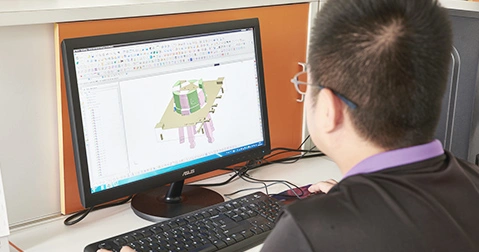The food and drug industry is heavily regulated by the FDA and other national agencies around the world. When it comes to prototyping and manufacturing for the food industry, the FDA lays some stringent guidelines that must be followed to alleviate and mitigate the risk of food contamination and poisoning.
Manufacturing for the food industry is a critical process that requires the careful selection of raw materials and processing techniques. According to the FDA, “materials used in the construction of utensils and food-contact surfaces of equipment must not allow the migration of deleterious substances or impart colors, odors or tastes to food.” Due to these guidelines and the consumer’s general safety, the materials chosen for food-grade prototypes must meet several criteria. Some of these criteria revolve around strength, corrosion, ease of cleaning, and more.
In homes and general applications, many materials are used for food-based applications. These materials can be plastic, metals, alloys, ceramic, wood, glass, or even foam. Products made from these materials can interact with food in a variety of ways. These may include containers, packaging materials, bottles, storage plastics, utensils, machinery, processors, electronics, refrigerator panels, and more. Because of these factors, companies that operate in the food and beverage industry must carefully consider each input and process before production. Below, we evaluate the reason for food-grade parts to be food safe. We then continue to the general FDA guidelines and finish off with the recommended materials for making food-grade prototypes.
Why should your materials and processors be food-safe?
Both manufacturing equipment and materials must be food-safe because of the direct or indirect contact they make with the food item. Before using any material or equipment to process or package any food item, the materials used in their production must be non-toxic and non-degradable. For example, processing food on iron surfaces may result in the leaching of corrosive substances into the food. This is very harmful and may result in severe ailments to the consumers. In less severe cases, packaging materials that are unfit for food-grade uses may impart unpleasurable appearance, odors, or tastes into the food.
In contrast, food-safe materials have a low migration rate and will hardly affect the content of the food materials processed or stored within.
The material-food dilemma
Asides from the qualification of material as food-safe, there has to be a significant compatibility level between the food and the packaging material. For instance, a manufacturing process that utilizes a considerable amount of salt cannot use a food-safe metal that will corrode in the presence of chlorides. A similar example exists with any container intended for microwave uses. Such containers will need to be heat resistant to prevent melting or warping into the food when used.
What do the FDA and EFSA say?
The Food and Drug Association (FDA) designates the following criteria for metal materials to qualify as safe for food use and prototypes:
• Safe
• Non-absorbent and non-corroding
• Smooth finish and easy-to-clean surface
• Scratching, scoring, chipping, pitting, and crazing resistant
• Sufficiency in mass and thickness to withstand repetitive washing
The EFSA stands for the European Food Safety Authority. This body states that Food Contact Materials (FCMs) “should be sufficiently inert so that their constituents neither adversely affect consumer health nor influence the quality of the food.”
What materials qualify?
Generally, any material that meets the laid-down conditions of the FDA should qualify for food-grade prototyping. The following materials, however, are the industry staple when making prototypes or final parts for the food industry:
• Aluminum
Aluminum is widely used for making cans, baking trays, and foils. The key characteristics of aluminum are its temperature tolerance, rapid heating and rapid cooling, lightweight, low cost, and corrosion resistance.
• Stainless Steel
The ease of cleaning and anti-corrosive properties of steel makes it an excellent fit for various food-grade applications. There are many formulations of stainless steel that are suitable for use in the food industry. These formulations include the 304, 430, 316 steel alloys. Below is s summary of the applications of these alloys:
o Steel 316 – Packaging materials, containers, equipment surfaces, and parts
o Steel 304 – Kitchenware and utensils
o Steel 430 – Packaging and containers for highly corrosive foods
• Titanium
Titanium is corrosion resistant and very suitable for heavy equipment components. It is used to make both machine parts and containers for certain types of food.
• Copper
Copper is susceptible to attack by acids. Because of this, it has a limited range of applications. The FDA stipulates that copper must not be used in contact with foods with a pH of < 6. Foods like vinegar, fruit juices and substances with a higher pH than milk are unsuitable for copper.
• Cast Iron
Cast iron is limited to cooking and serving uses only according to the guidelines of the FDA. This is because cast iron is deemed vulnerable to corrosion and oxidation during other food-related processes. For any other events, cast iron must not be utilized for any food-contact surface applications. It is generally used for making heavy pots and pans.
• HDPE
High-density polyethylene is suitable for making food-grade plastic prototypes for bottles, storage buckets, and containers. It is insect, mold, rot, corrosion, and cracking-resistant. It also has a very good strength-to-weight ratio.
• LDPE
Low-density polyethylene is majorly used for heat sealing purposes. It can make waterproof inner container layers, beverage packaging materials, cling wraps and wrap films. It is chemical and impact resistant and also has adequate strength and flexibility.
• PET
PET is a popular plastic in the beverage industry. It is used for making jars, bottles, containers, and other storage plastics. It has excellent impact resistance and dimensional stability.
• Polypropylene
PP is ideal for making disposable containers that are microwave-safe. It has a high melting point, excellent thermal resistance, and doesn’t react when exposed to acidic or alkaline foods.
Technologies for making your prototype
Prototyping goals can be achieved with an array of techniques. However, depending on how critical the project is and the size of your budget, you may have to compromise between functional and non-functional prototyping.
Solutions like 3D printing and vacuum casting may be useful for many prototype applications but may not be suitable when shifting to production. Here’s a closer look at all your options for food-grade prototyping:
Polyurethane vacuum casting employs silicone molds to make affordable food-safe containers and plastic items for prototyping. Silicone itself is food-safe and bio-compatible.
• 3D printing
3D printing can be deployed for low-cost, speedy prototyping. The only downside lies in the rough texture and crevices that may arise to the harbor of germs or bacteria.
• CNC machining
CNC machining is perfect for all levels of prototyping in the food industry. It can manufacture heavy equipment parts, containers, stainless steel surfaces with high precision, tight tolerances, and complex geometries.
• Die casting
Die casting can be used to prototype heavy pots, iron skillets, and food-safe parts with thin walls and tight tolerances.
• Injection molding
Injection molding can process all food-grade thermoplastics into finely finished prototypes. If not prototyping in large volumes, the injection molding process can be relatively expensive.
• Sheet metal fabrication
Sheet metal fabrication can use steel 304 and 316 to make flat, precision surfaces for heavy-duty machinery and kitchenware prototypes.










